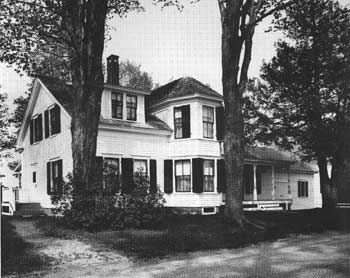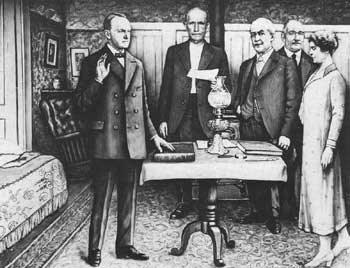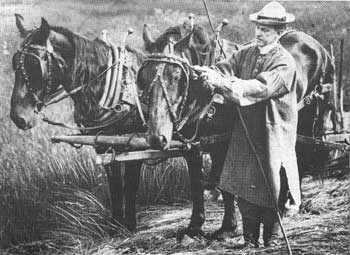






Survey of
Historic Sites and Buildings
 |
Coolidge Homestead Vermont |
 Coolidge Homestead |
| ||
This modest frame and clapboard farmhouse, nestled in the remote and picturesque hill country of Vermont, was the boyhood home of Calvin Coolidge. Although he spent most of his adult life outside the State, he often returned to the old homestead to visit his family and never lost his fondness for it. During the early hours of August 3, 1923, he took the Presidential oath of office there.
In 1876, when Coolidge was 4 years old, his father, "Colonel" John Coolidge, purchased the homestead, a simple, 1-1/2-story farmhouse connected to a barn by a shed. He repaired the house, bought some new furniture, and added the front piazza and bay windows in the sitting room, but subsequently made few other changes. Calvin lived in the house until 1887, the year he entered Black River Academy, in nearby Ludlow. In 1895, upon graduating from Amherst College, he took up the practice of law and settled in Northampton, Mass.
 |
| Coolidge Homestead. (National Park Service, Ralph M. Brouchoud, 1976.) |
Through the years, while pursuing a successful political career, Coolidge returned to Plymouth to call on his family as often as duty would allow. On one of these occasions, during the night of August 2, 1923, when he was serving as Vice President of the United States, he was awakened with news of President Harding's sudden death in San Francisco. In a dramatic ceremony, held about 2:47 a.m. in the sitting room of the homestead, Coolidge's father, a notary public and justice of the peace, swore him into office as President. Witnessing the ceremony were Mrs. Coolidge; U.S. Representative Porter H. Dale, who happened to be staying nearby; L. L. Lane of the Railway Mail Association; and Coolidge's chauffeur and stenographer. Later, Coolidge repeated the oath in his apartment at the Willard Hotel in Washington, where he was staying pending Mrs. Harding's departure from the White House.
 |
| Upon President Harding's sudden death, Calvin Coolidge took the oath of office from his father at his boyhood home in Vermont during the early hours of August 3, 1923. Watching (left to right) are Vermont Senator and former Representative Porter H. Dale, L. L. Lane of the Railway Mail Association, and Mrs. Calvin Coolidge. (Lithograph, in the Boston Sunday Post, Mar. 1, 1925, Library of Congress.) |
When his father died a few years later, Coolidge inherited his boyhood home, but continued to spend most of his time in Northampton, where he died in January 1933. The homestead remained in the possession of the Coolidge family until 1956, when Coolidge's only surviving son, John, donated it and all the furnishings to the State. The next year, following the death of Mrs. Calvin Coolidge, it formally accepted the gift, dedicated the building as a historic shrine, and opened it to the public. It appears almost exactly today as it did on the night of the inauguration. Because Coolidge's father had refused to install modern conveniences such as electricity, gas, and telephones and because no alterations occurred after his death, the house is exceptionally well preserved.
The State still owns and administers the boyhood home, the first floor of which is open to the public. The main house is connected to the barn by a series of rooms, including the buttery, woodshed, toolroom, laundry room, and shed bedroom. The latter features the bed in which Coolidge was born at a nearby residence and a quilt he made in his youth.
The most elaborate room in the main house, a formal parlor that was used only on special occasions, contains the black walnut, horsehair-covered furniture that "Colonel" Coolidge purchased at the time he bought the house, as well as the original rug, lace curtains, and cast-iron stove. The sitting room, known as the "Oath of Office Room" because it was the scene of Coolidge's inauguration, displays the table, Bible, and kerosene lamp used in that ceremony. Because the upper floor is inaccessible to the public, the State has refurnished a first-floor bedroom with items from the upstairs bedroom that President and Mrs. Coolidge occupied when visiting. The kitchen, which overlooks the front porch, contains, among other original items, a cast-iron wood stove and a table set for four. Adjacent to the kitchen is the pantry.
 |
| Calvin Coolidge in his Vermont fields. (National Park Service, Boucher, 1976.) |
Elsewhere in Plymouth, several other historic structures associated with Coolidge are extant, some of which are open to the public. Directly across the street from the homestead is Union Church, a typical New England church attended by Coolidge throughout his life when he was in town. Adjacent to it stands a structure that incorporates Coolidge's birthplace, a 1-1/2-story house at the rear, and a large, two-story ell, a later addition at the front, in which Coolidge, Sr., operated a general store. During the Presidential campaign of 1924, Coolidge maintained an office on the second floor of the store, probably because his father would not permit telephones to be installed in the homestead. The State acquired the entire structure in 1967 and has partially restored it.
| ADDITIONAL INFORMATION |
|
The Calvin Coolidge Memorial Foundation |
Another State-owned structure is the Wilder House, a two-story building just east of the homestead that was once the home of Coolidge's aunt and uncle and the birthplace of his mother. It serves as a restaurant and hospitality center. Across the street and to the east of the Wilder House stands the Farmer's Museum originally the Wilder barn but now a State-owned and operated museum of 19th-century farm and household items. Not far to the west of the homestead is the Cheese Factory, established about 1890 by "Colonel" Coolidge and reactivated by Calvin's son John in the early 1960's. Near it is an old schoolhouse, presently operated as a gift shop.
Plymouth Notch Cemetery, about a mile southwest of the homestead on the south side of Vt. 100A contains the graves of President and Mrs. Coolidge, their youngest son, Calvin, Jr., who died in 1924 at the age of 16, and several Coolidge ancestors.
 |
 |
http://www.cr.nps.gov/history/online_books/presidents/site60.htm
Last Updated: 22-Jan-2004